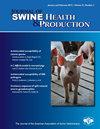Evaluation of Sow Caliper for body condition measurement of gestating sows
IF 0.7
4区 农林科学
Q3 Agricultural and Biological Sciences
引用次数: 0
Abstract
Objectives: To evaluate correlation between Sow Caliper measurement and backfat depth (BFD), and to determine the ideal caliper measurement that predicts optimal BFD prefarrowing to support performance of lactating sows. Materials and methods: Multiparous sows (n = 928, Parity 1-9) were group housed in pens from day 35 to 109 of gestation. Caliper measurements, BFD, visual body condition scores (BCS), and body weight were recorded upon sows’ entry and exit of gestation pens. Subsequent farrowing performance was recorded. Caliper measurements were classified into five categories: category 1 = 4.0 to 8.0 units, category 2 = 8.5 to 10.0 units, category 3 = 10.5 to 12.0 units, category 4 = 12.5 to 14.0 units, and category 5 = 14.5 to 18.0 units. Results: Caliper measurement was correlated positively with BFD (r = 0.71-0.75; P < .001) and BCS (r = 0.67-0.75; P < .001) on days 35 and 109 of gestation. Based on sow performance over one reproduction cycle and BFD recommendations, caliper category 4 on day 109 of gestation was deemed ideal for prefarrowing sows. The estimated lower and upper limits of BFD for prefarrowing sows in caliper category 4 were 15.6 and 18.0 mm, respectively. Caliper measurements explained about 55% of variation in BFD of gestating sows prefarrowing. Implications: The Sow Caliper can be used to evaluate body condition of gestating sows. To maintain body condition and reproductive performance, caliper measurements of 12.5 to 14.0 units are recommended for prefarrowing sows across parities, excluding gilts.母猪卡尺用于妊娠母猪体况测量的评价
目的:评估母猪卡尺测量值与背肥深度(BFD)之间的相关性,并确定预测最佳背肥深度的理想卡尺测量值,以支持泌乳母猪的生产性能。材料和方法:多胎母猪(n=928,1-9胎次)于妊娠第35天至第109天分组圈养。在母猪进入和离开妊娠圈时,记录卡尺测量值、BFD、视觉身体状况评分(BCS)和体重。记录随后的产仔表现。卡尺测量分为五类:1类=4.0至8.0个单位,2类=8.5至10.0个单位,3类=10.5至12.0个单位,4类=12.5至14.0个单位和5类=14.5至18.0个单位。结果:在妊娠第35天和第109天,卡尺测量值与BFD(r=0.71-0.75;P<.001)和BCS(r=0.67-0.75;P<.001)呈正相关。根据母猪在一个繁殖周期内的表现和BFD建议,妊娠第109天的4类卡尺被认为是预育母猪的理想选择。第4类繁殖母猪的BFD估计下限和上限分别为15.6和18.0毫米。卡尺测量解释了怀孕母猪在出栏前BFD变化的55%。提示:母猪卡尺可用于评估怀孕母猪的身体状况。为了保持身体状况和繁殖性能,建议对不同胎次的预育母猪(不包括母猪)进行12.5至14.0单位的卡尺测量。
本文章由计算机程序翻译,如有差异,请以英文原文为准。
求助全文
约1分钟内获得全文
求助全文
来源期刊
CiteScore
1.80
自引率
0.00%
发文量
29
审稿时长
>36 weeks
期刊介绍:
The Journal of Swine Health & Production (JSHAP) is an open-access and peer-reviewed journal published by the American Association of Swine Veterinarians (AASV) since 1993. The aim of the journal is the timely publication of peer-reviewed papers with a scope that encompasses the many domains of applied swine health and production, including the diagnosis, treatment, management, prevention and eradication of swine diseases, welfare & behavior, nutrition, public health, epidemiology, food safety, biosecurity, pharmaceuticals, antimicrobial use and resistance, reproduction, growth, systems flow, economics, and facility design. The journal provides a platform for researchers, veterinary practitioners, academics, and students to share their work with an international audience. The journal publishes information that contains an applied and practical focus and presents scientific information that is accessible to the busy veterinary practitioner as well as to the research and academic community. Hence, manuscripts with an applied focus are considered for publication, and the journal publishes original research, brief communications, case reports/series, literature reviews, commentaries, diagnostic notes, production tools, and practice tips. All manuscripts submitted to the Journal of Swine Health & Production are peer-reviewed.

 求助内容:
求助内容: 应助结果提醒方式:
应助结果提醒方式:


